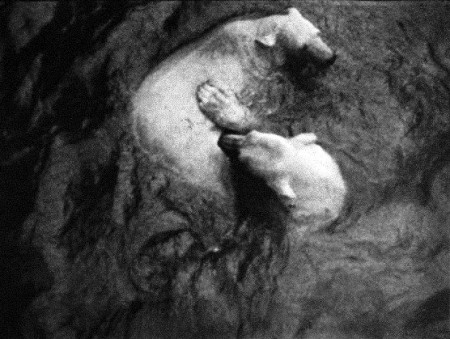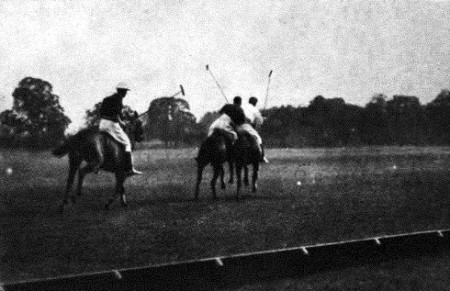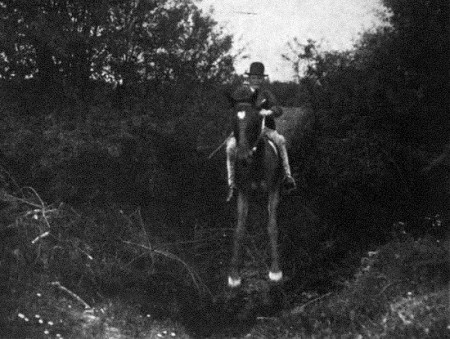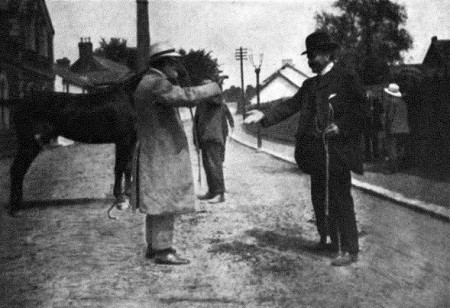Sport with a Camera
comad August 30th, 2014
The Badminton Magazine of Sports and Pastimes
digitised by Google – photos forgottenbooks.com
volume 21 July-Sept 1905
SPORT WITH A CAMERA
by Lilian E. Bland
page 196
My experiences with a camera are not written scientifically for advanced workers in the art of photography, but on the chance of helping other amateurs who, like myself, want to make their camera pay for its keep, or for those who amuse themselves by ”snap- shotting” their favourite sports. The Gordon Bennett race [1] of 1903 first gave me the idea of turning my camera into a useful ‘pot boiler’. The hunting season was a joy of the past, and consequently our funds also were at the lowest ebb; so my friend and I started off on bicycles to ‘do’ the Gordon Bennett course, taking photographs of all the dangerous corners the cars would have to round, and aiming at getting original views so as to avoid the type of pictures professionals were taking. We sometimes rode fifty miles a day, and this, with a 7 lb. penalty up in the shape of my ‘ Reflex, ‘ kept one very fit.

POLAR BEARS PLAYING IN THE WATER
One evening as we were returning to our headquarters we met a quaint character of the old type of peasant. She had a black clay pipe in her mouth, hanging upside down, alas ! with no ‘baccy to fill it. On her head was a white frilled bonnet, and a shawl and red flannel skirt completed her picturesque appearance. We pulled up and gave her ‘a soft day,’ but she regarded us with a mistrustful eye. When I meekly asked to be allowed to take her photograph she either could not or would not understand – she only grunted and said that she had no money. My feelings were distinctly hurt. I explained that I was not a ‘highwayman,’ but all in vain, and even a cigarette shredded into her pipe had no soothing effect. She departed unpacified, and only the memory of her quaint figure remains.
Our tour financially was a great success, and later on we went down the day before the race to photograph all the different teams, and by pure luck we got a roof over our heads that night. Sleep was quite impossible; there certainly was a straw mattress, but we preferred the floor, after we had upset the water jug over it, and having made fortifications of the invaluable “Keating” we rested with our faithful cameras as pillows – and they were not soft. Racing cars shrieked past all night long, and at 3 a.m. we were riding off to the club enclosure. We had to get back to the North that day, and finally arrived at my aunt’s house at 1 a.m., having bicycled out six miles from the station. I then started developing the negatives, and remember with sadness that I only had three hours sleep in the same number of days and nights, so that I cannot recommend this kind of press work to anyone who values a peaceful existence.
Our next venture was the motor trials at Castlewellan, but arriving rather late we found ‘all traffic suspended,’ so we calmly ‘ held up ‘ a passing racer, which kindly whizzed us over the course and deposited us on the press stand. Here, among other amusing incidents, a correspondent asked me what paper I represented? I promptly said ‘Huntings’ and, seeing that he looked rather surprised, I fixed him with a stern and frigid eye. I hope he is still asking for the journal called ‘Hunting’.

RIDING OFF — POLO AT ROEHAMPTON
My camera, in fact, is best acquainted with horses and the chase ; but, unfortunately, one cannot carry a camera and hunt at the same time. One of the most ridiculous falls I ever saw happened at a small fence with a ditch on the near side. The steed refused ; the rider shot on to his neck, which he embraced with arms and legs, and the wise horse with great deliberation put down his head and lowered the man into the very muddy ditch — what a snapshot missed ! Someone should invent a flying machine that would behave properly ; it would be the only way to get good hunting pictures — only one would make enemies for life by telling some of the ‘schemers’ just where they really were in a good run.
My camera is a ‘Reflex,’ and the great advantage of this type is that one has a full-sized view-finder, and can focus up to the last moment if necessary ; it is fitted with a Goerz lens and focal plane shutter. In taking any special positions of horse-jumping, a ‘Reflex’ is absolutely necessary, and even with its help one requires the eye of a cinematograph [2] to release the shutter at the right moment ; but only practice can make perfect in this respect.
If horses are jumping at a show, or for your benefit, the easiest way is to make up your mind first in what position you mean to take them, and then to focus for that particular place. Using a Goerz lens with full aperture one has to be very accurate, or the negative will be out of focus. One of the pictures shows the ridiculous effect of delay in releasing the shutter. The horse made a bigger spring out than I had allowed for, and narrowly missed landing on the top of me, which is one disadvantage of having one’s bead bent over the view-finder.

THE RESULT OF DELAY IN RELEASING SHUTTER
When taking photographs of racing, polo, etc., the best plan is to use your camera like a gun, sight the object at a distance, and follow it along, when you can ‘pull the trigger’ at the right moment ; this also requires a steady hand. As to exposure, give as slow a release as the movement will allow — and there is a very wide limit:
1-600th sec. is fast enough for racing and jumping at any speed, and if the horses are foreshortened 1-150th sec, 1-450th sec. will give a sharp image. The closer one stands near the horse, the faster the exposure required, and vice versa. Dilute your developer with plenty of water, which may be slightly warmed, and a few drops of bromide will prevent any tendency to fogging; nothing can beat pyro-soda. [3] A simple way of slightly intensifying a negative is to dry it over a lamp or stove by holding the glass side towards the heat; at a certain temperature the image will show up in low relief, and then the plate is allowed to cool spontaneously; if heated beyond this stage the film will melt with disastrous results. It is useless to try quick instantaneous work on a dull day ; it is merely waste of plates.

CONCLUDING THE BARGAIN AT AN IRISH HORSE-FAIR
The only fault of the ” Reflex ” is its weight. Mine has over- balanced me sometimes when bicycling, and one amusing accident occurred when we were doing the ‘Leps of Tipperary.’ My friend, riding her cob, was towing me along with a rein, and the ‘whip’ was riding beside me, when on turning a corner rather sharply my bicycle skidded, the camera swung out over my shoulder, and not being able to recover, I fell with a fearful crash under the feet of the terrified horse. Either the horse or the camera gave me a stunning blow on the head. The ‘whip’ afterwards explained pathetically that it must have been the camera, as the horse was entirely occupied in trying to climb over a donkey and cart which was passing at the time. Fortunately neither the camera nor the horse was the worse for the adventure.
Patience must ever be the motto of the photographer who aspires to get good studies of animals, especially if the animal happens to be a hound ; for he will either frantically wave his stern and grin at you, or else he will sit down and yawn, but never by any chance will he stand in the correct position to show off his good points. If you love them, however, and study their varied characters and habits, the time spent in their society will certainly not be wasted, even although a few of your negatives will be ‘thrown out.’
Notes:
Gordon Bennett Race: 2nd July 1903
The course was over 300 miles long starting from Ballyshannon and finishing at Athy. The cars were required to keep within the national 12 mph speed limit when passing through towns and villages and for safety reasons, the cars had to follow behind bicycles when passing through towns on the route. Of the twelve cars which started the race only five completed the course. The Athy circuit (1903) became the first international motor race run on a closed circuit and was also the first time that regulations allocated national colours to the competing cars thus creating ‘British Racing Green’. Racing was not permitted in the UK (12mph limit). John Scott Montague MP drafted the Light Locomotives (Ireland) Act 1903, which would “shall only remain in force until 31st December 1903.”
The Act (27th March) exempted cars from any statutory speed limit on the day of the race. To overcome any political opposition by County Councils, the legislation included an incentive or ‘sweetener.’ The carrot dangled in front of the newly formed Local Authorities (formed in 1899) was that the legislation would absolve County Councils from all road improvement costs on the chosen route. Cash-starved County Councils embraced the Gordon Bennett Race with the enthusiasm and fervour of a papal visit, and what County Councillor could say no to such a gift horse? This gift being the filling of almost ninety miles of pot-holes and the hope for Councillors to be re-elected.
The world press attention was now firmly focused on the chosen routes in counties Laois, Carlow and Kildare.The race started at the Ballyshannon cross-roads. Wikipedia notes that:
“Letters were sent to 102 Irish MPs, 90 Irish peers, 300 newspapers, 34 chairmen of county and local councils, 34 County secretaries, 26 mayors, 41 railway companies, 460 hoteliers, 13 PPs, plus the Bishop of Kildare and Leighlin, Patrick Foley, who pronounced himself in favour.”
* The historic Gordon Bennett route *
Cinematograph
A cinematograph is a motion picture camera. On June 19, 1873, Eadweard Muybridge successfully photographed a horse named “Sallie Gardner” in fast motion using a series of 24 stereoscopic cameras. The cameras were arranged along a track parallel to the horse’s, and each camera shutter was controlled by a trip wire triggered by the horse’s hooves. They were 21 inches apart to cover the 20 feet taken by the horse stride, taking pictures at one thousandth of a second. In 1882, French scientist Étienne-Jules Marey invented a chronophotographic gun, which was capable of taking 12 consecutive frames a second, recording all the frames of the same picture.
Pyro-Soda as a developer
From “The Barnet Book of Photography” C. H. Bothamly – 1898.
When sodium carbonate is used as the alkali in place of ammonia the developer acts somewhat more slowly and is less liable to produce fog, especially with very rapid plates, and there is very little tendency to produce green fog.
- Comments(0)